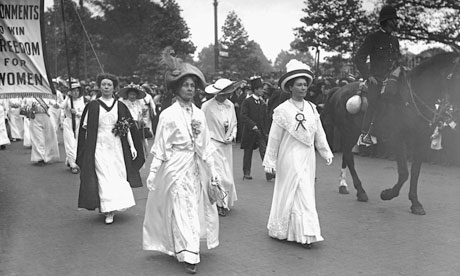The Twentieth Century observed
more women gaining the right to vote than during any other time in history. Few
women gained suffrage prior to 1900 and astonishingly a few countries still
deny women this essential human right in 2014. Women’s suffrage movements
especially took off at the turn of the century, and there was an international
component as female suffragists began to travel and saw both the injustices and
freedoms experienced by women in other countries. This is exemplified in the
1915 and 1919 conferences held by suffragettes and social reformers from
Germany, England, and the United States. Over one thousand delegates attended
the anti-war conference in 1915 and formed the Women’s International League for
Peace and Freedom, meeting again in 1919, in Zurich, to promote world peace and
to advocate for the rights of women and other minorities (CP 205). Clearly by
this point, the women’s movement had reached an international scale and while
focused mostly on the suffrage movement in their own countries, suffragettes such
as Emmeline Pankhurst were definitely aware of the events and circumstances of
women in other areas of the globe.
Included in the Introduction to
Emmeline Pankhurst’s Suffrage Speech at the
Old Bailey is the statement that the
“Women’s Social and Political Union, founded in 1903 by Emmeline Pankhurst,
attracted large crowds at suffrage demonstrations and adopted the militant
tactics of the Irish independence movement” (CP 202). This statement alludes to
the fact that the suffragette’s decision to turn to violent demonstrations did
not occur in a vacuum. There were events
happening in Europe that had a direct influence upon the movement. In Pankhurst’s
1912 speech, delivered during her trial at the Old Bailey criminal court, she
plainly expresses why WSPU members were forced into militancy. They experienced
violence from the government and were treated as common criminals for simple
acts such as creating petitions, banners, and attending political rallies and
asking politicians about their stance on women’s rights. Between 1903 and 1912,
Pankhurst and many other suffragettes were imprisoned and treated with excessive
cruelty and punishments compared to their crimes. The example of women involved
in militant acts abroad as well as Pankhurst’s view that violence was necessary
undoubtedly added to the WSPU’s turn towards militancy.
At the end of Pankhurst’s speech,
she uses the example of an Irish woman’s trial in which she was being charged
with murder. Because she was young and unmarried, the judge ruled that her
father needed to be present and held partially responsible for her actions.
Pankhurst uses this example from Ireland to show that if she was guilty of something, because she was
a woman and had few rights, men should actually be held responsible for her
violent actions. She asks how men can judge her in court when her sex has no
say in British laws nor are they allowed to participate in the judicial system.
Because the suffragettes were only reacting to harsh treatment from the
authority, Pankhurst asserted that “If we are guilty of this offence, this
conspiracy, other people, some of the members of His Majesty’s Government,
should be in the dock by our side” (CP 205). Pankhurst’s speech demonstrates
that she understood not only laws in her own country, but that she was also
aware of legal circumstances of women in Ireland.
Emmeline Pankhurst being arrested.









